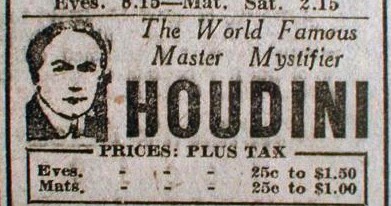
Although he’s been gone for nearly 100 years, most people know at least a thing or two about Harry Houdini. Whether it be for his legendary illusions or his thrilling escapes from handcuffs, water tanks, and straight jackets, the magic man’s name is synonymous with mystery.
Unfortunately, so is his death.
- You might also like:
- "Paris of the North": how Montreal roared through Prohibition in the 1920s
- Test your wits: Can you pass this Montreal history quiz?
In order to understand what really killed the illusionist and how Montreal played a pivotal role in his downfall, we must start at the beginning.
Houdini, was born Erik Weisz in Budapest in 1874. Upon coming to America as a child, Weisz became infatuated with the work of French illusionist Jean-Eugène Robert-Houdin, so much so that he adopted the name (with an added vowel) as his own. As a teenager, Weisz was already performing stunts and feats under his new stage persona.
By the early 20th century Houdini was touring Europe and quickly becoming a household name around the world. For the next two decades, he rose up the ranks of magic through death-defying stunts, escapes, and theatre performances.

spatuletail / Shutterstock
In the mid-1910s Houdini began serving as president of the Society of American Magicians. He also tried his hand as a movie star and writer. By then, Houdini has established a friendship with Sir Arthur Conan Doyle, the author behind Sherlock Holmes. Doyle introduced Houdini to his love of spiritualism and deep belief in the supernatural.
But after attending multiple séances (often in disguise) and meeting with countless spiritualists, Houdini developed a strong disdain for the fraudulent nature of the practice. And as an illusionist himself, he was able to quickly identify a con artist when he saw one. By the 1920s debunking these spiritualists had become Houdini’s main focus. He co-authored multiple works on the subject and even incorporated them into his new stage show named “Three Shows in One: Magic, Escapes, and Fraud Mediums Exposed.”
Despite injuries, the magician, now in his early fifties, continues to tour and perform. It was also common for him to conduct lectures on debunking spiritualism at educational institutions along the way.
In October of 1926, Houdini was in Montreal to perform at the Princess Theatre on Sainte-Catherine Street. During his brief stint in town, Houdini visited McGill University to give a presentation on his recent debunking of a Boston medium.

wildabouthoudini.com

Princess Theatre / lhpm.uqam.ca
According to McGill’s archives, after the presentation, at least two students came to visit him in his dressing room: Jocelyn Gordon Whitehead and Samuel J. Smilovitz, who decided to sketch Houdini. During the meeting, Whitehead wanted to challenge Houdini’s strength and asked if the claims about the magician being able to absorb punches were true. Houdini apparently agreed, but before he was able to prepare himself the student delivered three punches to his stomach.
Whitehead’s damage to Houdini’s stomach seemed to aggravate a pre-existing (undetected) case of appendicitis. Houdini, who was no stranger to discomfort, pushed through the pain and performed in Montreal despite his failing health. As the pain persisted and worsened, Houdini refused a proposed trip to the hospital.
Days later he collapsed on stage in Detroit and was finally sent to the hospital. Although Houdini, who had a fever of 104°F, was given hours to live, he held on for about a week until finally succumbing to the infection. Houdini passed away on Halloween, a day many people deemed fitting for the magician and larger-than-life figure.
While he didn’t die in Montreal, contrary to popular belief, it is the city where Houdini met his unfortunate fate.
Some say his spirit still haunts the grounds of the now-abandoned old Princess Theatre (476 St. Catherine Street West).

